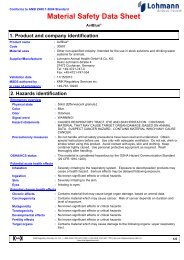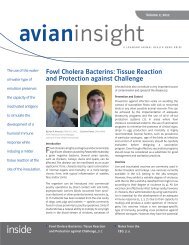Farm Vaccination - Injection Method Oil Emulsion Vaccines
Farm Vaccination - Injection Method Oil Emulsion Vaccines
Farm Vaccination - Injection Method Oil Emulsion Vaccines
Create successful ePaper yourself
Turn your PDF publications into a flip-book with our unique Google optimized e-Paper software.
<strong>Method</strong> of Application<br />
To achieve the maximum potential from killed vaccines, each bird must be properly injected with a full dose of<br />
vaccine. Vaccine can be injected intramuscularly (IM) in the breast, wing, leg or tail head or subcutaneously (SQ) in<br />
the neck. When injecting SQ , use an 18-gauge, 1/2 inch needle. An 18-gauge, 1/4 inch needle should be used when<br />
injecting IM.<br />
Neck - The skin on the back of the neck should be lifted up to create a pocket between the skin and neck muscles.<br />
Insert the needle through the skin into this pocket with the needle pointing toward the bird’s body. The site of injection<br />
should be the middle to lower neck region on the dorsal mid-line of the neck. There will be resistance as the<br />
needle passes through the skin followed by free movement into the SQ space. If this difference is not noticed or is<br />
followed by resistance again, the needle may be in the skin, the neck muscle or the spinal cord. Avoid injecting vaccine<br />
into the neck muscles, intradermally or too close to the head.<br />
Breast - Vaccine is injected into the superficial pectoral muscle about 1 to 1.5 inches lateral to the keel bone, depending<br />
on the age of the bird. The needle should be directed caudally at a 45º angle to the body. This will help avoid<br />
injecting the vaccine through the muscle and into the body cavity.<br />
Leg - When using the leg muscle for vaccination, the injection should be made in the lateral side of the gastrocnemius<br />
muscle mid-way between the stifle joint and the body. The needle is directed proximally. Avoid major vessels,<br />
nerves, joints and the bone.<br />
Wing - The wing muscle (medial side of the biceps) can be used as an alternative IM site. The injection is made into<br />
the large muscle group on the under side of the wing. The needle is pointed toward the body. Avoid major vessels<br />
and the bone.<br />
Tail Head - This injection is made into the underside of the tail head. The needle is directed to the side of the tail<br />
bone and pointed cranially. Care should be taken to not withdraw the needle too quickly. A fast withdrawal can lead<br />
to leakage of vaccine out of the injection site.<br />
There is always the concern that one injection site may produce superior immunity to another. Research has shown<br />
that all common injection sites can give satisfactory results if done properly. Mutalib et. al. found only minor differences<br />
in antibody titers in birds vaccinated in the thigh, breast, wing and neck a with Newcastle (ND) vaccine and<br />
no difference in titers with Infectious Bronchitis vaccine. Glisson et. al. vaccinated birds with Pasteurella multocida<br />
bacterin in the tail, wing, leg, breast and the neck. There was no significant difference in ELISA titers or in protection<br />
when challenged. When selecting the injection site, consideration should be given to ease of application, reaction at<br />
the injection site and human safety. Comparisons to decide which injection site gives the best result in an individual<br />
operation may be helpful.<br />
Monitoring<br />
<strong>Vaccination</strong> should be monitored to ensure the full potential of the vaccine is achieved. Serology is useful in evaluating<br />
the birds’ response to vaccination. ELISA is the most widely used test. Virus neutralization (VN) is another<br />
valuable test. VN shows the level of neutralizing, or protective, antibodies. Hemagglutination inhibition (HI) can be<br />
used for ND, paramyxovirus - type 3 and avian influenza. The antibody level and uniformity of the flock’s immune<br />
response will help give some indication of the vaccination crew’s technique.<br />
Evaluation should also include visits to the field to work with the vaccination crew. <strong>Vaccination</strong> crews should be<br />
educated in proper technique and vaccine handling. To evaluate the crew’s vaccination technique, the injection site<br />
should be examined shortly after vaccination. With the SQ neck injection, the feathers at the injection site can be<br />
separated to allow visualization of the vaccine under the skin. To see vaccine through the skin, examination should<br />
be done within an hour of vaccination. As the time between vaccination and examining birds increases, the vaccine<br />
will disperse into the SQ tissue and be difficult to see. The feathers around the injection site should be dry. Wet<br />
feathers may be the result of early retraction of the needle, vaccination through both layers of skin or vaccine leakage<br />
out of the injection site. Vaccine will leak back if a large bore needle is used, the needle has a spur or the vaccine<br />
is not injected deep enough into the tissue.<br />
Prevention first.
















